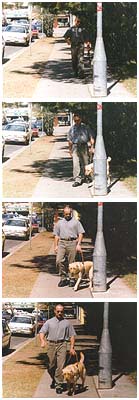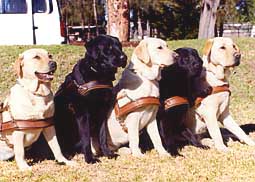Go Back
|
Go Back |
|
|
Before a dog starts its proper guide dog training, it has to be assessed to see if it has the right temperament. A dog who wants to fight with other dogs, or is scared of traffic, is no good as a guide dog. |
|
The dogs are taught by very experienced
dog trainers, and have to learn a lot of complex
skills. One thing they must do, is learn to avoid
obstacles. On the left you can see the dog taking
its handler around the lamp post, when he walks straight at
it. The dog also has to avoid things that are
not a problem for a small dog, but are a problem for a
person, who stands a lot taller. A guide dog cannot walk its
handler into a branch of a tree sticking out that would hit
the person, even though the dog would pass by safely
underneath the branch. This is quite difficult to teach the
dog. Guide dogs also must be able to sit
quietly when they are working, and to ignore distractions.
They learn that when they are wearing their harness, they
are working. When it is taken off, then they know that they
can play around like a normal dog, and have fun. Training a dog for guide work is a team
effort. Guide dog instructors, dog trainers, kennel
attendants and volunteer puppy raisers all help to give a
dog the best job a dog could have. At 7am every day the dogs are taken
outside and toileted. Afterwards they are fed. Meals are a balanced diet and carefully
measured. Dogs are taught to wait until the O.K. to eat is
given. They are also taught to toilet on
command. This is important as a working dog travels on
public transport, enters shopping centres and goes to work
with its owner. After a day's training it's back to the
centre for some relaxation time. Dogs are kept indoors in
kennels overnight. Dogs have Saturday and Sunday off to
relax, have a bath, a bone, a free run and a bit of
pampering from the kennel staff. And it's back to work on
Monday.

